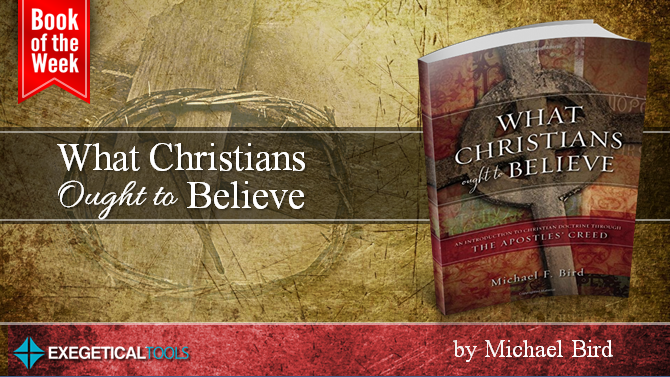Teaching Christian doctrine is no easy task, and making it interesting is even harder. Since Augustine’s On Christian Teaching, manuals of doctrine and hermeneutics have flooded the church, but for me the real test is whether I can use a book in a small group in my church. Mike Bird’s What Christians Ought to Believe passes that test with flying colors, preeminently because he argues for using the creeds to teach theology and models how to do it.
Using the Creeds to Teach Doctrine
Here is a creative format for teaching doctrine: merging it with church history so laypeople and students learn both together, as it should be. Although many in Baptist and related traditions might shun the use of the Apostle’s creed as the outline of a book on doctrine, Bird briefly relates why creeds are biblical, useful, and even spiritually enriching (chs. 1-2). This important section might also help a church understand why using creeds in worship services isn’t strange or antiquarian.
In addition to teaching through the Apostle’s creed, Bird also explains the history and contents of the other two ecumenical creeds and the Chalcedonian Definition (25-26). The back of the book contains an appendix with the early texts and traditions associated with the Apostle’s creed.
Doctrine through Commentary
The rest of the book is a commentary on the Apostle’s creed, phrase by phrase, beginning with a chapter on “I believe,” explaining biblical faith. Then follow chapters on the Father, the Son, the virgin birth, and so forth.
The chapters are helpfully concise and read as a mixture between biblical and systematic theology. Bird is definitely drawing from his larger work, Evangelical Theology, whose massive size (912 pp.) demonstrates his competency to write this shorter introduction to Christian doctrine (239 pp. total). Ample citations support most assertions, which allows the teacher to lead students or laymen to passages for further study.
As in any book, not everyone will agree with Bird’s interpretation on every passage. When explaining the “he descended into hell” line, he correctly points to several Fathers who interpret Eph 4:8 as support for this belief and follows them (I think, correctly). He also follows the Fathers in interpreting “he took captive captives/captivity” as Jesus’ rescue of the saints from Sheol, thus taking captive their captivity (I think incorrectly). But the phrase from Ps 68:18 is militant language for God’s taking captive the Canaanites, and the psalmist borrows the phrase from Judg 5:12 where Barak is told to take captive the Canaanites in battle. So in Ephesians, the phrase refers to Jesus taking captive the enemy (i.e., the spiritual powers [Eph 1:21; 2:2; 3:10; 6:10]).
Little quibbles arise throughout the book as with any book on doctrine(!), but one can never claim Bird hasn’t done his homework. This little book is a truthworthy guide to Christian doctrine, a faithful exposition of the Apostle’s creed, and a useful work for the classroom or for small groups or church classes. I would also say it outclasses its most recent competitor, Doctrine, by Driscoll and Breshears.

Michael Bird is a New Testament scholar and Lecturer in Theology at Ridley College in Australia.
A Witty Aussie
If you’re going to use a book with your church, it can’t only be informative; it has to be engaging. Bird keeps you engaged throughout with his witty quips and Aussie charm.
Who else compares the Bible and creeds to “Vegemite and avocado?” I don’t even know what that is, and I’m guessing I don’t want to know, but it’s a fun way to launch a chapter (ch. 2).
Again, Christians will be delighted to know that when they take the mysterious leap of faith–which Mike delightfully defines as wholehearted trust in the person of Jesus–they, like Neo in the Matrix, take the red pill (p. 54). The book stays focused on teaching doctrine but throws in some lighthearted cultural references just in right places when readers might be tempted to lose focus.
Final Evaluation
What Christians Ought to Believe is useful, creative, and teaches systematic theology, church history, and historical theology all at the same time. Kudos! I may personally use this work in my church and perhaps in teaching as well. It would make an excellent textbook for Christian colleges, an engaging resource for laypeople, and a downright fun read for theology buffs.
Preview or buy it here on Amazon.


